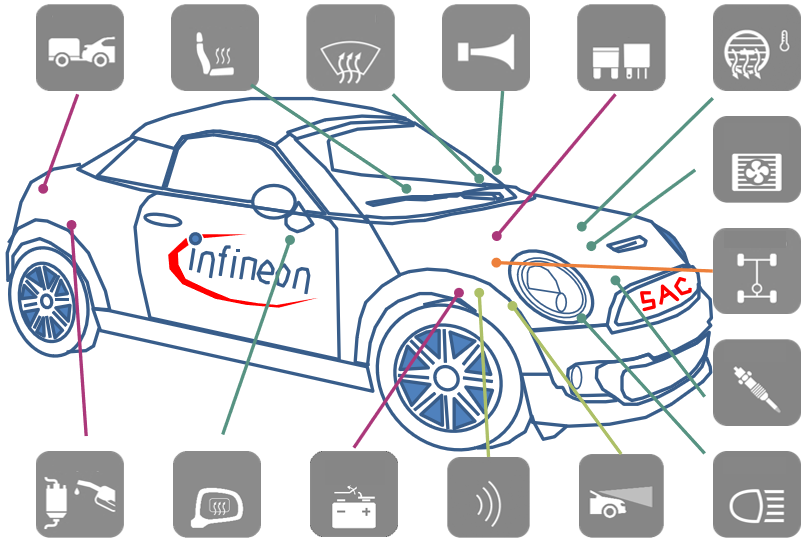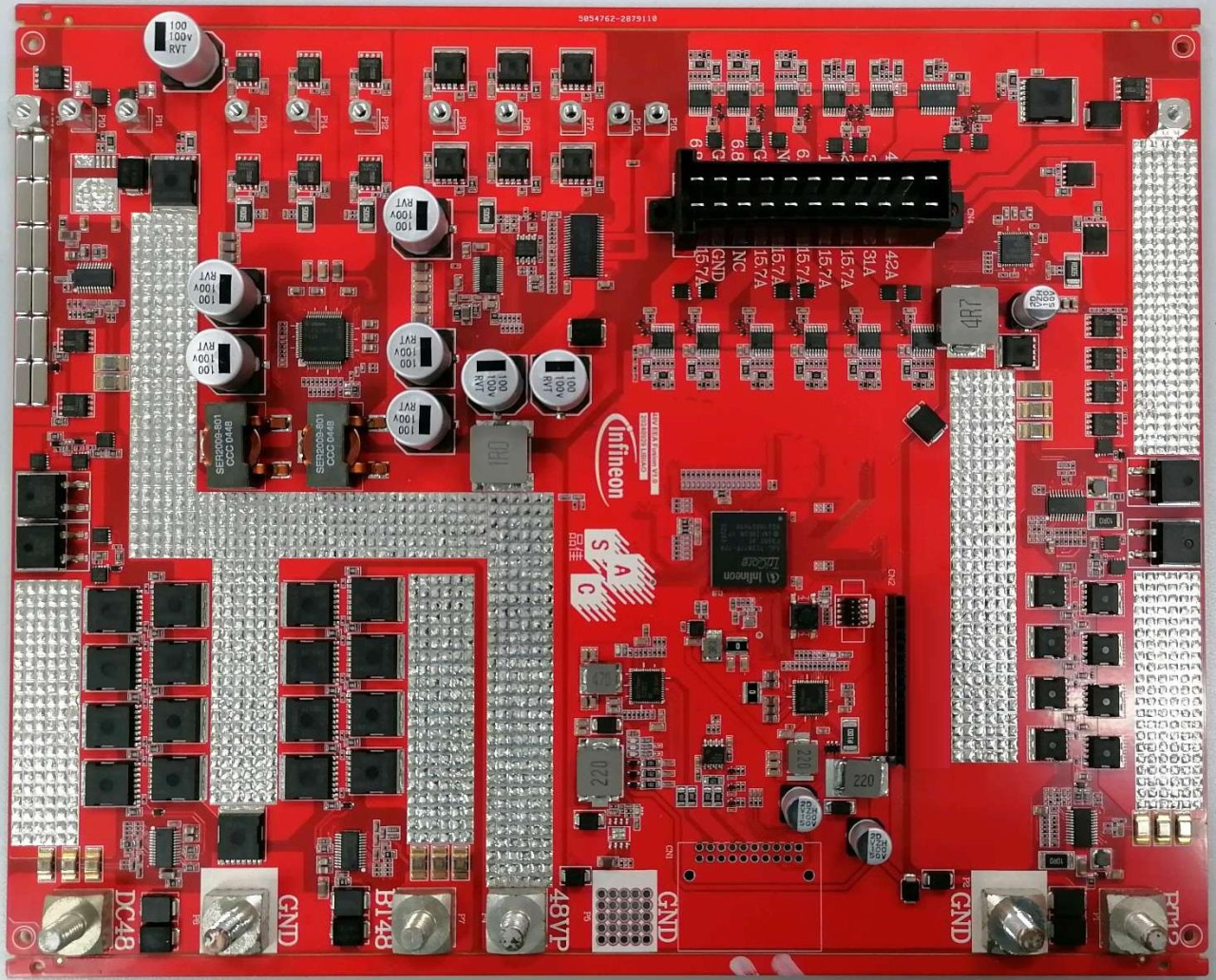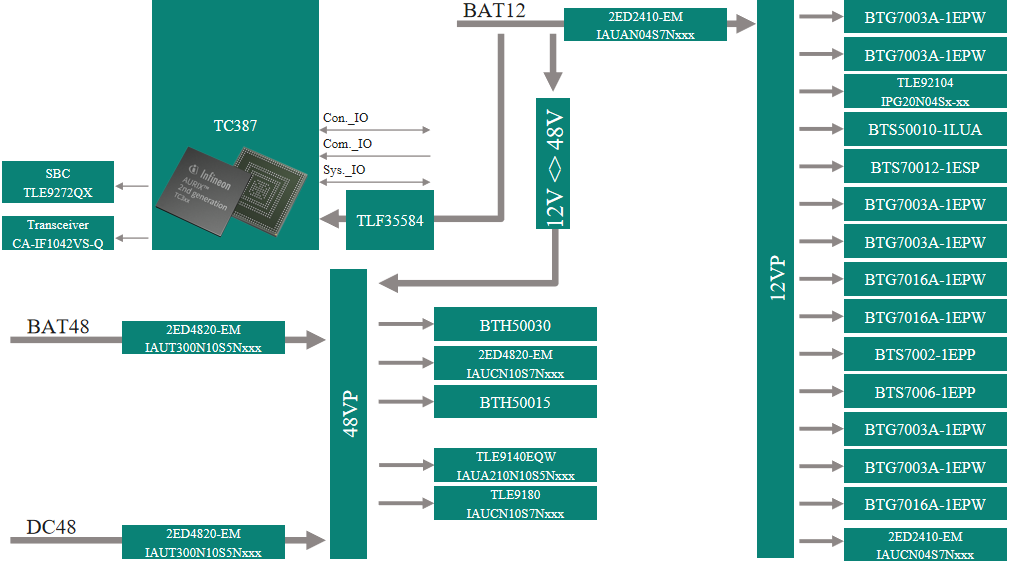48V EEA solution based on Infineon TC387+TLF35584+TLE9140+2ED4820+2ED2410
In 1886, German Karl Benz used the world's first horseless tricycle, bringing mankind into the modern automobile industry era. Today, more than a hundred years later, the automobile industry has become an important part of modern industry. The types of cars have also evolved from traditional gasoline cars to various types such as oil hybrids, plug-in hybrids, extended range, pure electric, and fuel cells. Driven by modern technology, automobile electrification, networking, and intelligence are developing rapidly, and automobiles are no longer a simple means of transportation. The development of the industry has made safety no longer a single goal. Various advanced demands such as comfort, convenience, and intelligence have also led to the development of automobiles from mechanical and electrical products to "electronic products". Automotive electronic and electrical architecture (EEA) integrates various sensing, decision-making, and execution components to coordinate the complex, safe, and orderly operation of the entire vehicle, bringing a good experience to users.
Evolution History of Passenger Car Low Voltage Systems
In the development of automobiles, from 1918 to the 1950s, 6V low-voltage systems were the mainstream. At that time, the on-board electrical appliances were not as abundant as they are today, and the main electrical equipment was lights and starters. Starting in the 1950s, in order to adapt to large-displacement engines, Yes, there is a 6V+6V series connection, which is a 12V low-voltage system. Later, with the gradual increase in electrical equipment, the 6V low-voltage system began to be unable to meet the needs of automotive electrical appliances. Gradually, all electrical equipment such as car windows, lighting, and cigarette lighters transitioned to 12V low-voltage systems. With the development of the times, the vehicle current has also increased from about 50A in the early days to about 250A today. In order to cope with the increasing electrification trend, the American Society of Automotive Engineers had the idea of increasing the low voltage of passenger cars to 42V in the 1990s. Perhaps the time was not ripe and the 42V system ultimately failed, but the development of automobiles did not stop; from 2010 to 2020s , under the influence of common factors such as growing vehicle load requirements and strict emission regulations, European and American car companies such as Audi, BMW, Daimler, Porsche, and Volkswagen jointly launched 48V systems and released the corresponding LV148 system specifications. With the official delivery of the Cybertruck using the 48V system in 2023, the 48V power system has once again become the focus of many car companies.
48V system advantages
Under the same load demand, when the voltage is increased, the current becomes smaller accordingly. This has the advantage of reducing wire harness loss, improving the overall energy efficiency of the vehicle, and increasing the cruising range. At the same time, there is an opportunity to reduce the weight of the wiring harness and obtain the benefit of reducing the cost of the entire vehicle. In terms of dealing with high-power loads, the 48V system can meet the needs of high-power electrical equipment, achieve diversified needs, and improve the experience of drivers and passengers. Of course, as a new development direction in the future, 48V systems may encounter some hiccups in R&D, design, testing and promotion at the beginning, but these are not problems. Under the general trend of the evolution of automotive electronic and electrical architecture (EEA), Market demand will solve everything.
Advantages of smart power devices
In traditional power distribution systems, mechanical relays switch power between the load and the battery. When the relay contacts open and close, an arc will be generated. If the stability and reliability of the system are considered, the selected relay needs to have an arc extinguishing function, which will increase the cost of the entire machine. In addition, as time goes by, contact aging is inevitable, and the expected life of the relay affects the long-term reliability of the entire vehicle. The smart power device products launched by Infineon cover the entire voltage range of 12V/24V/48V and can reliably switch large current loads under various voltage platforms. The consistent advantages of Infineon smart power devices are low on-resistance, low thermal resistance, high current, high accuracy, rich diagnostics, comprehensive protection, and complete product categories. In addition to high-side and low-side switches, for higher-current power distribution applications, the design adopts a pre-drive + MOSFET solution, which balances practicality and cost-effectiveness. The new generation of pre-driver 2ED2410 and 2ED4820 are gate drivers specially designed for high-current automotive applications. They have strong gate output capabilities and can drive multiple MOSFETs in parallel, thereby minimizing conduction losses. Supports back-to-back structures such as common source and common drain; the chip provides a variety of protection mechanisms including power supply under-voltage and over-voltage detection, gate-source under-voltage detection, drain-source over-voltage detection; configurable over-current protection, integrated over-temperature warning and protection, etc. Diagnostic protection function, ideal for automotive EEA applications.
Pinjia Group has developed a 48V EEA solution based on Infineon TC387+TLF35584+TLE9140+2ED4820+2ED2410 in response to the market demand for 48V applications. This solution allocates high-power loads such as chassis, power amplifiers, and thermal management to the 48V system. It also takes into account the actual conditions during the transition period from 12V to 48V. The traditional 12V system distributes low-power loads such as radar, lights, wipers, doors and windows, etc. on the body. At the same time, a wealth of 12V/48V load channels are reserved, with current ranges from amps to hundreds of amps. At the same time, the 12V system and 48V system can also work independently to meet various expansion needs.
Scenario application diagram

Development board diagram

Solution block diagram

Core technical advantages
1. Safety: Under-voltage and over-voltage detection, over-current detection, over-temperature detection and various diagnosis and protection ensure the safety and robustness of the system.
2. Flexibility: Configurable over-current protection, compatible with 12V and 48V low-voltage platforms
3. Expandable: different power levels can be expanded with different MOSFETs
Solution specifications
1. Input: 12V/48V
2. Output: 48V100A, 12V200A
3. Load type: supports resistive, capacitive, and inductive loads
4. Function: Support lighting, heating, power distribution and BLDC, BDC drive to meet the needs of new electronic and electrical architecture for electric vehicle systems
